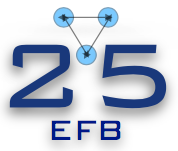Speaker
Description
Extensive and precise investigations have been conducted on lithium-like neon, iron, and krypton, focusing on the energy levels, wavelengths, weighted oscillator strengths, transition rates, line intensity ratios, and plasma parameters of their lowest 35 odd and even parity states arising from the $1s^2nl (n = 1−6,0 ≤ l ≤ n−1)$ configurations. Accurate atomic data determination is considered to be the principal way to effectively solve the future energy problem as a clean and infinite energy resource [1] and it is being developed internationally via the International Thermonuclear Experimental Reactor (ITER) Project [2]. Both experimental and theoretical spectroscopic studies have been performed in the last few years in order to estimate the power loss from the impurities in the forthcoming fusion reactors. These calculations involved the Multiconfigurational Dirac-Hartree-Fock (MCDHF) method [3] followed by the Relativistic Configuration Interaction (RCI) method. Electric-multipole (dipole (E1), quadrupole (E2)) and magnetic-multipole (dipole (M1), quadrupole (M2)) transition rates were also determined. The calculations incorporated Breit interactions and quantum electrodynamics effects (QED) as perturbations within the extensive relativistic configuration interaction (RCI) approach. Comparison of our findings with existing theories in the literature and data from the NIST database revealed a substantial level of agreement. Additionally, the line intensity ratio and plasma parameters (plasma temperature and electron density) were determined. These comprehensive and coherent results have significant implications, aiding in the identification of observed spectral lines in astrophysical studies [4, 5], and contributing to the effective control of nuclear fusion reactions in tokamak plasmas [6, 7].
References:
[1] Cummings J, Cohen SA, Hulse R, Post DE, Redi MH and Perkins J. Journal of nuclear materials 176 (1990) 916.
[2] A J H, Donne et al, Nucl. Fusion. 47, 337 (2007).
[3] Bieron J, Froese Fischer C, Gaigalas G, Grant IP and Jönsson P. Computer Physics Communications 237 (2019) 184.
[4] Mishenina TV, Soubiran C, Kovtyukh VV, Katsova MM, Livshits MA. Astronomy & Astrophysics 547 (2012) A106.
[5] Garca Prez A E, Primas F. Astronomy & Astrophysics 447 (2006) 299.
[6] Gorczyca TW, Dumitriu I, Hasoglu MF, Korista KT, Badnell NR, Savin DW and Manson ST. Astrophysical Journal 638 (2006) L121.
[7] Das GC and Sarma J. J. Phys. Plasmas 5 (1998) 3918.

